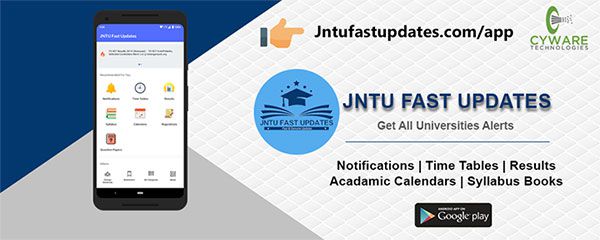JNTUK R20 2-1 EMF Material/Notes PDF Download
Students those who are studying JNTUK R20 EEE Branch, Can Download Unit wise R20 2-1 ELECTRO MAGNETIC FIELDS (EMF) Material/Notes PDFs below.

JNTUK R20 2-1 EMF Material/Notes PDF Download
Preamble: Electromagnetic field theory is the pre-requisite for most of the subjects in the gamut of electrical engineering. The study of this subject enables students to understand and interpret the phenomenon pertinent to electrical engineering using microscopic quantities such as electric and magnetic field intensities, scalar and vector potentials.
Course Objectives: This course is designed to:
- To study the production of electric field and potentials due to different configurations of static charges.
- To study the properties of conductors and dielectrics, calculate the capacitance of different configurations. Understand the concept of conduction and convection current densities.
- To study the magnetic fields produced by currents in different configurations, application of Ampere’s law and the Maxwell’s second and third equations.
- To study the magnetic force and torque through Lorentz force equation in magnetic field environment like conductors and other current loops.
- To develop the concept of self and mutual inductances and the energy stored.
- To study time varying and Maxwell’s equations in different forms and Maxwell’s fourth equation for the induced EMF
UNIT-1
Electrostatics: Coulomb’s Law – Electric Field Intensity (EFI) – EFI due to a line and a surface charge, work done in moving a point charge in an electrostatic field, electric potential – potential gradient, Gauss’s law – Maxwell’s first law (div(D)=ρv), Laplace’s and Poison’s equations and solution of Laplace’s equation in one variable.
Electrostatics Scalar and vector fields, overview of coordinate system, calculus of scalar and vector fields in Cartesian coordinates – Coulomb’s Law – Electric Field Intensity (EFI) – EFI due to a line and a surface charge, work done in moving a point charge in an electrostatic field, electric potential – properties of potential function – potential gradient, Guass’s law –Laplace’s and Poison’s equations.
Download UNIT-1 Material PDF | Reference-2 | Ref-3
UNIT-2
Conductors – Dielectrics and Capacitance: Electric dipole – dipole moment – potential and EFI due to an electric dipole, Torque on an Electric dipole in an electric field, conductors and Insulators – their behavior in electric field. Polarization, boundary conditions between conductor to dielectric, dielectric to dielectric and conductor to free space. Capacitance of parallel plates, spherical dielectrics, energy stored and energy density in a static electric field, current density, conduction and convection current densities, Ohm’s law in point form – equation of continuity.
Download UNIT-2 Material PDF | Reference-2
UNIT-3
Magneto statics, Ampere’s Law and Force in magnetic fields: Biot-Savart’s law and its applications viz. Straight current carrying filament, circular, square, rectangle and solenoid current carrying wire – Maxwell’s second Equation (div(B)=0), Ampere’s circuital law and its applications viz. MFI due to an infinite sheet, long filament, solenoid, toroidal current carrying conductor, point form of Ampere’s circuital law, Maxwell’s third equation (Curl (H)=J)
Magnetic force, moving charges in a magnetic field – Lorentz force equation, force on a current element in a magnetic field, force on a straight and a long current carrying conductor in a magnetic field, force between two straight long and parallel current carrying conductors.
Download UNIT-3 Material PDF | Reference-2
UNIT-4
Self and mutual inductance: Self and mutual inductance – determination of self-inductance of a solenoid and toroid and mutual inductance between a straight long wire and a square loop wire in the same plane – energy stored and density in a magnetic field
Download UNIT-4 Material PDF | Reference-2
UNIT-5:
Time Varying Fields: Faraday’s laws of electromagnetic induction – integral and point forms, Maxwell’s fourth equation (Curl(E)=-∂B/∂t), statically and dynamically induced EMF – modification of Maxwell’s equations for time varying fields, displacement current, Poynting theorem and Poynting vector.
Download UNIT-5 Material PDF | Reference-2
Text Books:
1. “Engineering Electromagnetics” by William H. Hayt & John. A. Buck Mc. Graw-Hill Companies, 7th Editon.2006.
2. “Principles of Electro Magnetics” by Sadiku, Oxford Publications, 6th edition, 2015.
Reference Books:
1. “Introduction to Electro Dynamics” by D J Griffiths, Prentice-Hall of India Pvt.Ltd, 2nd edition
2. “Electromagnetic Field Theory” by Yaduvir Singh,Pearson.
3. FFundamentals of Engineering Electromagnetics by Sunil Bhooshan, Oxford University Press,2012.
4. Electromagnetics by Joseph A. Edminister, Schaum’s Outline,4th Edition,2014
Course Outcomes:
- determine electric fields and potentials using Guass’s law or solving Laplace’s or Possion’s equations, for various electric charge distributions.
- calculate and design capacitance, energy stored in dielectrics.
- calculate the magnetic field intensity due to current, the application of Ampere’s law and the Maxwell’s second and third equations.
- determine the magnetic forces and torque produced by currents in magnetic field
- determine self and mutual inductances and the energy stored in the magnetic field.
- calculate induced EMF, understand the concepts of displacement current and Poynting vector.


320-x100(1).gif)
